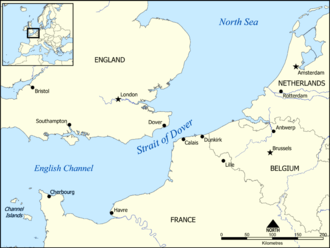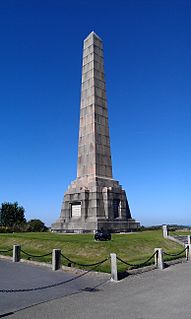
The Dover Barrage was an underwater blockade by England of German submarines attempting to use the English Channel during World War I. The barrage consisted of explosive mines and indicator nets. A similar barrage was used in World War II.

The Dover Barrage was an underwater blockade by England of German submarines attempting to use the English Channel during World War I. The barrage consisted of explosive mines and indicator nets. A similar barrage was used in World War II.
The barrier consisted of minefields laid between Belgium and Dover at the outbreak of war, followed in February 1915 by 25 km of Indicator nets, steel netting anchored to the sea bed. [1] The first evidence of effectiveness was on 4 March 1915, when the German U-boat U-8 was taken, caught in the indicator nets. [1] [2]
The first stage of the barrage was completed in April 1915 and it was patrolled by ships of the Dover patrol. [2]
Both sides initially believed the barrier to be effective and the Germans attributed some submarine losses to it. However, in March 1916, the Germans found their submarines could traverse the Channel on the surface at night.
The British moved the barrier to cover Folkestone-Cap Gris Nez and used new mines and searchlights, effectively closing the Channel to hostile submarines in August 1918. [1] Underwater scanning of the area covered by the Dover Barrage shows the wreck of SM UB-109 broken in half. [3]
A mine barrage was also used in Dover during the 1940 Siege of Calais.

The Otranto Barrage was an Allied naval blockade of the Otranto Straits between Brindisi in Italy and Corfu on the Greek side of the Adriatic Sea in the First World War. The blockade was intended to prevent the Austro-Hungarian Navy from escaping into the Mediterranean and threatening Allied operations there. The blockade was effective in preventing surface ships from escaping the Adriatic, but it had little or no effect on the submarines based at Cattaro.

Constructed using light steel nets, indicator nets were often anchored at various depths to the sea bed around Allied naval bases during both world wars. They were intended to entangle U-boat traffic of the enemy, even though the submarines often managed to disentangle themselves and escape before being blown up by depth charges.
German submarine U-260 was a Type VIIC U-boat built for Nazi Germany's Kriegsmarine for service during World War II. Her keel was laid down 7 May 1941 by Bremer Vulkan, of Bremen-Vegesack. She was commissioned 14 March 1942 with Kapitänleutnant Herbertus Purkhold in command.

Anti-submarine warfare is a branch of underwater warfare that uses surface warships, aircraft, submarines, or other platforms, to find, track, and deter, damage, and/or destroy enemy submarines. Such operations are typically carried out to protect friendly shipping and coastal facilities from submarine attacks and to overcome blockades.

HMS Ghurka was a Tribal-class destroyer built in 1907 for the Royal Navy. She served as part of the Dover Patrol during the First World War, playing a part in the sinking of the German submarine U-8 in 1915, and was sunk by a German mine in 1917.
SM U-103 was an Imperial Germany Navy Type U 57 U-boat that was rammed and sunk by HMT Olympic during the First World War. U-103 was built by AG Weser in Bremen, launched on 9 June 1917 and commissioned 15 July 1917. She completed five tours of duty under Kptlt. Claus Rücker and sank eight ships totalling 15,467 gross register tons (GRT) before being lost in the English Channel on 12 May 1918.

SM U-27 was a German Type U-27 U-boat built for service in the Imperial German Navy. She was launched on 14 July 1913, and commissioned on 8 May 1914 with Kapitänleutnant Bernd Wegener in command.

HMS Viking was a Tribal-class destroyer of the Royal Navy launched in 1909 and sold for scrap in 1919. She was the only destroyer ever to have six funnels.
HMS D5 was one of eight D-class submarines built for the Royal Navy during the first decade of the 20th century.

The Dover Patrol and later known as the Dover Patrol Force was a Royal Navy command of the First World War, notable for its involvement in the Zeebrugge Raid on 22 April 1918. The Dover Patrol formed a discrete unit of the Royal Navy based at Dover and Dunkirk for the duration of the First World War. Its primary task was to prevent enemy German shipping—chiefly submarines—from entering the English Channel en route to the Atlantic Ocean, thereby obliging the Imperial German Navy to travel via the much longer route around Scotland which was itself covered by the Northern Patrol.

PS Duchess of Montrose was a paddle steamer launched in 1902 and operated by the Caledonian Steam Packet Company as a River Clyde excursion steamer. She saw active service during the First World War after being requisitioned by the Admiralty and converted into a minesweeper. She was lost near Dunkirk on 18 March 1917 after striking a mine.
SM UC-44 was a German Type UC II minelaying submarine or U-boat in the German Imperial Navy during World War I. The U-boat was ordered on 20 November 1915 and was launched on 10 October 1916. She was commissioned into the German Imperial Navy on 4 November 1916 as SM UC-44. In 6 patrols UC-44 was credited with sinking 28 ships, either by torpedo or by mines laid. UC-44 was sunk by the detonation of one of her own mines off the Irish coast at position 52°07′N6°59′W on 4 August 1917; its commander, Kurt Teppenjohanns, was the only survivor. UC-44's wreck was raised by the Royal Navy in September 1917 and later broken up.
SM UC-51 was a German Type UC II minelaying submarine or U-boat in the German Imperial Navy during World War I. The U-boat was ordered on 20 November 1915 and was launched on 5 December 1916. She was commissioned into the German Imperial Navy on 6 January 1917 as SM UC-51. In seven patrols UC-51 was credited with sinking 28 ships, either by torpedo or by mines laid. UC-51 was mined and sunk in the English Channel on 17 November 1917.

The U-boat Campaign from 1914 to 1918 was the World War I naval campaign fought by German U-boats against the trade routes of the Allies. It took place largely in the seas around the British Isles and in the Mediterranean. The German Empire relied on imports for food and domestic food production and the United Kingdom relied heavily on imports to feed its population, and both required raw materials to supply their war industry; the powers aimed, therefore, to blockade one another. The British had the Royal Navy which was superior in numbers and could operate on most of the world's oceans because of the British Empire, whereas the Imperial German Navy surface fleet was mainly restricted to the German Bight, and used commerce raiders and unrestricted submarine warfare to operate elsewhere.

The Atlantic U-boat campaign of World War I was the prolonged naval conflict between German submarines and the Allied navies in Atlantic waters—the seas around the British Isles, the North Sea and the coast of France.

The Battle of Dover Strait that occurred on 26–27 October 1916 was a naval battle of the First World War between Great Britain and the German Empire. Two and a half flotillas of German torpedo boats from the Flanders Flotilla launched a raid into the Dover Strait in an attempt to disrupt the Dover Barrage and destroy whatever Allied shipping could be found in the strait.
'The Admiralty M-N Scheme' was a World War I British plan to close the Strait of Dover in the English Channel to German U-boats, by means of a chain of either eight or twelve massive towers linked by anti-submarine booms and nets. Only two towers had been constructed before the Armistice with Germany caused the cancellation of the project.

SM UB-109 was a German Type UB III submarine or U-boat in the German Imperial Navy during World War I. She was commissioned into the German Imperial Navy on 31 December 1917 as SM UB-109.

German submarine U-1191 was a Type VIIC U-boat of Nazi Germany's Kriegsmarine during World War II.

SMS V47 was a V25-class Large Torpedo Boat of the Imperial German Navy that was built and served during the First World War.